Blue Rose Turn Black Ministy Video Blue Rose Boat Video Aids Spanish
- Suntory Global Innovation Center
- > Research & Technology
- > First in the world! Challenge for "blue roses"
- > Stories of development
Research & Technology

Stories of development>
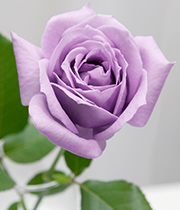
The term "blue rose" in English signified "the impossible (a non-existent object)" because nobody could produce blue roses by hybridization breeding no matter how much they were desired. However, "the impossible" has become possible due to cutting-edge biotechnologies and the continuous efforts of scientists dedicated to producing blue roses. Senior General Manager, Yoshikazu Tanaka, Ph.D., who has participated in the blue rose project since the initiation of the project, Principal Researcher Yukihisa Katsumoto, Ph.D., who still engages in the study as the project leader, and Researcher Noriko Nakamura, Ph.D. talked about their passion and aspirations that led to the success of the development of blue roses.
1990 The Blue Rose Project started

Producing blue roses---The challenge to the impossible started in 1990. Suntory decided to tackle this dreamful project in collaboration with an Australian venture company Florigene Ltd. (named Calgene Pacific Pty Ltd. then; hereinafter referred to as Florigene). Thanks to the rapid advancement of plant biotechnologies in the 1980s, it was expected that blue roses could be developed with these technologies. Thus, there were many research teams engaged in similar projects to produce blue roses in the world, and the competition had already started under cover.
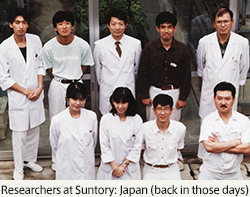
There were two technical barriers that had to be solved to produce blue roses. One was to "isolate genes (blue genes) necessary to synthesize a blue pigment (delphinidin) from among tens of thousands of genes contained in blue flowers." The other was to "develop the methods to introduce these genes to cells of roses and produce genetically modified roses from these cells." It was especially necessary to solve the first issue of isolation of blue genes earlier than the rivals and apply for the patent of the gene because such genes were patentable.
The challenge to produce "blue roses," which signify the impossible, started. −-Senior General Manager Yoshikazu Tanaka Ph.D.

Blue genes were isolated from petunias, and the patent of the gene was filed
There are many plants that produce blue flowers in nature, but our research team first chose a petunia exhibiting a dark violet color in order to isolate blue genes. This was because the petunia had already served as a model plant for the research of flower pigments (such as anthocyanin) and their biosynthesis and the following knowledge had already accumulated:
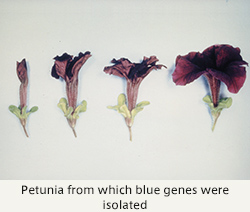
- Blue genes are cytochrome P450 type hydroxylase (enzymes involved in detoxification in the liver) genes.
- These genes work in petals but not in leaves.
- Red petunias that do not produce blue pigments do not have blue genes.
- Blue genes work most actively when petals are opening.
- Gene loci on the chromosomes were known.
We selected about 300 kinds of candidate genes from about 30,000 kinds of genes in petunias in order to identify the two blue genes of petunias. Our first plan was to introduce the candidate genes into petunias and observe flower color changes to determine whether they were actually blue genes. However, this method required several months until flowers bloomed to see color change. Therefore, to reduce the time required to obtain results, we decided to introduce the candidate genes of blue genes to yeast instead of plants and test their enzymatic activities in yeast. Thanks to this method, we obtained results in one week and were able to test the activities of many genes.
Finally, we succeeded in isolating blue genes on June 13, 1991.
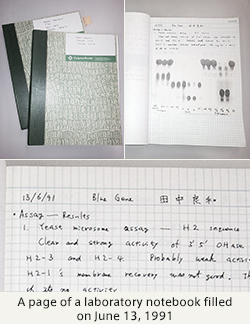
Suntory and Florigene immediately applied for the patent of the blue genes. Because we applied for the patent earlier than any other competitors and monopolized the intellectual property right, we were able to engage in this research eliminating any competitors. We were also lucky to be granted with broad claims because our applications were the first ones for patents of genes with this kind of activity. Actually, introduction of these genes into petunias and tobacco resulted in the increase of blue pigments "delphinidin." Our paper describing these results was published in "Nature," the most prestigious scientific journal in the world.
The time when we discovered blue genes was the happiest moment of my research life. −-Senior General Manager Yoshikazu Tanaka Ph.D.

1994 Roses into which petunia blue genes were introduced flowered, but they showed no hint of blue
There are several methods to introduce genes into plants. In the blue rose project, we adopted a method of introducing them with using a soil bacterium called "Agrobacterium." Because this bacterium has the ability to carry its own genes into plant cells, it is used in the gene transfer of many plants. To select only cells that have received the genes after transfer and regenerate them into the plant body of roses, it is necessary to optimize plant hormones as well as kinds and concentrations of nutrients. The work to perform this procedure in sterilized conditions, using a plant in a test tube, is called "tissue culture."
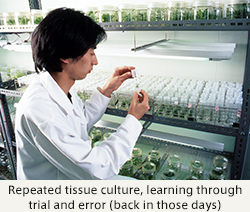
In the case of roses, it takes about one year from the introduction of genes to the blooming. How effectively the introduced genes function differs from one genetically modified rose to another, so we have to produce as many genetically modified roses as possible. Efficiency of gene introduction also differs substantially by rose variety. Therefore, we continued tissue culturing, learning through trial and error
Finally, we were able to introduce genes to red roses. For the first time in 1994, roses to which two kinds of blue genes of petunia opened. However, the color of the flowers was still red and no blue pigment was detected although the genes were introduced without a doubt.
Color changes or delphinidin were not observed even after many promoters (DNA sequence regulation gene expression) were used to drive petunia blue genes. Thus, we decided to introduce blue genes other than from petunias to roses. We isolated blue genes from various plants with blue flowers, such as gentian, butterfly pea, and torenia, and introduced them into roses. However, no matter how many times we conducted experiments, only "roses with blue genes but without blue pigments" bloomed.
We even suspected that roses might decompose blue pigments.... −-Senior General Manager Yoshikazu Tanaka Ph.D.

We had many failures, but each of them taught us a useful lesson for the future −−Principal Researcher Yukihisa Katsumoto Ph.D.

1995 Succeeded in producing blue carnation
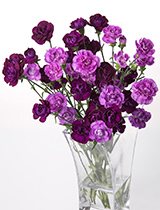
We could not harvest the fruits of our efforts, and hard times continued for the members involved in this project. What encouraged the researchers was the success of the development of genetically modified blue carnations. Blue genes of petunia did not work well in roses, but they worked as expected in carnations. The blue pigments "delphinidin" accumulated, and the color of flowers changed to blue.
These flowers, named "Moonseries," were put on sale in Japan in 1997, and the number of varieties has increased since then. These elegant and beautiful flowers, which signify "eternal happiness" in the language of flowers, have gained popularity.
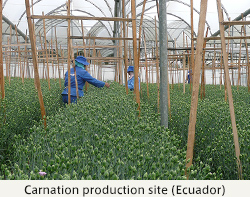
Moonseries are the first genetically modified flowers in the world that were commercialized. Currently, these blue carnations are produced in Columbia and Ecuador, and are sold primarily in the USA, but in Europe and some countries as well. In Japan, six varieties with different dark and light color combinations are sold. Presently, not only blue genes of petunias but also those of pansies are used for some varieties.
"Blue carnations" were born using an additional gene to blue genes −-Senior General Manager Yoshikazu Tanaka Ph.D.

1996 Blue pigments finally accumulated in roses, too; flower color changed
Around that time, in addition to carnations, blue pigments started to be produced at last in roses by introducing blue genes isolated from a pansy. Clear color changes of roses were also finally observed. However, because we introduced these genes only into a red rose variety, these roses were far from something that could be called "blue rose," and their color was darkish red. Nevertheless, the production of blue pigments showed us a path to the birth of blue roses.
Even after blue pigments are produced, how blue the flower become depends greatly on the original characteristics of the roses to which genes are introduced. For example, if the pH is low (acidic) in the cell vacuoles in which blue pigments are accumulated, the color becomes red, and if it is neutral, the color becomes blue. The color also depends largely on whether components that can or cannot enhance blue exist in the vacuoles. In other words, the existence of blue pigments does not necessarily turn the flower color into blue.
We therefore chose, from among several hundred varieties, about 40 rose varieties which would be likely to result in the accumulation of a high percentage of blue pigments and a more bluish color, including those that were not commercialized, and continued experiments to introduce the blue genes in order to produce roses that really would look blue. At the same time, we continued our research to improve methods of tissue culture so that genes could be introduced into various rose varieties.
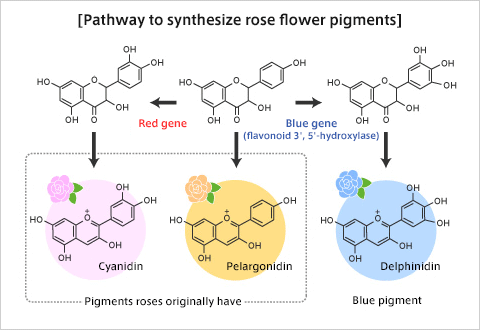
We were excited about the prospect of blue roses coming! −-Senior General Manager Yoshikazu Tanaka Ph.D.

Our research was worthwhile though we had to cope with pressure −−Principal Researcher Yukihisa Katsumoto Ph.D.

1998-2002 The percentage of blue pigments increased to 100%; blue roses were finally born
To introduce genes into rose cells, we first need to induce undifferentiated cells (called "callus") whose functions or morphology has not been determined yet. In other words, blue genes are introduced into calluses for which no determination has been made as to whether they may become a part of a leaf or a stalk. We regenerate these cells to produce flowers. It takes as long as one year to produce calluses, so this experiment takes time and requires extreme patience. The researchers patiently devoted themselves to continue the work of introducing the blue genes of pansies into calluses. This was a method originally developed by Suntory. This technique forms the basis of the development of blue roses because it enables the introduction of genes into many rose varieties.
Around 1998-1999, slightly bluish roses started to bloom. We further continued gene transfer, and due to that effort, roses which accumulated almost 100% of the total blue pigments bloomed. In 2002, we selected transgenic lines of pure blue from them. Finally, the first blue roses in the world were born. Further, we succeeded in propagating these roses by grafting, and confirmed that roses of the same color were produced stably and grown normally.
Pursued blueness by trying various varieties −-Senior General Manager Yoshikazu Tanaka Ph.D.

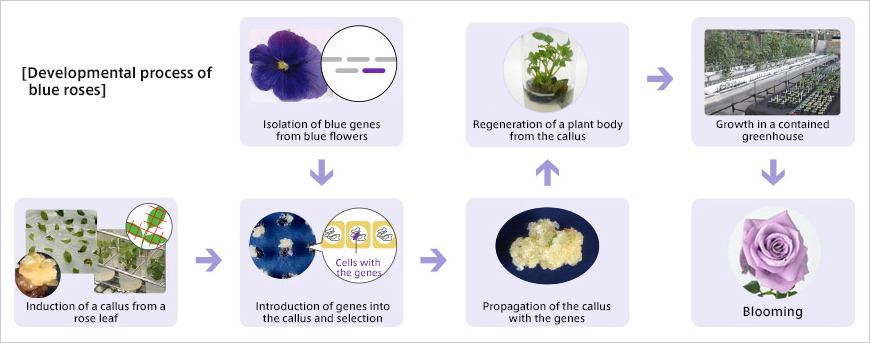
2004 Finally the success of the development was announced
In June 2004, we publicly announced the first success of the development of blue roses in the world, and showed them publicly in the press conference room. We received huge responses. The success was reported on the front pages of various newspapers, and covered by mass media overseas. The general consumer was also greatly interested, and warm responses were received from many people, including elementary school students and the elderly. The stories of the development of blue roses are included in scientific textbooks, exhibited at the National Museum of Nature and Science, and used in many teaching materials. We published some papers on the scientific aspects of the development, and received the PCP Award of the Japanese Society of Plant Physiologists in 2009.
However, we had to overcome another and possibly the highest hurdle before delivering blue roses to consumers. Because the blue roses developed by Suntory are genetically modified organisms, it was necessary to obtain legal permits from the Ministry of Agriculture, Forestry and Fisheries and the Ministry of Environment based on Act on the Conservation and Sustainable Use of Biological Diversity through Regulations on the Use of Living Modified Organisms (so-called Cartagena Protocol) in order to grow them commercially and sell them in Japan.
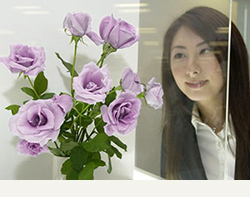
For that purpose we had to conduct various experiments to prove that the production and sales of the developed roses in Japan would not affect Japanese biological diversity. For example, we spent as long as four years to conduct hybridization experiments including cross-pollinating the blue roses with wild rose species in order to prove that there was no risk of dispersal of the introduced genes among wild roses. We obtained the permits on January 31, 2008.
The news on the birth of blue roses made headlines around the world −-Senior General Manager Yoshikazu Tanaka Ph.D.

We traveled to the wilderness in Hokkaido to obtain permits --Researcher Noriko Nakamura Ph.D.

2009 Blue roses were marketed, and the pursuit to improve the blue color continued
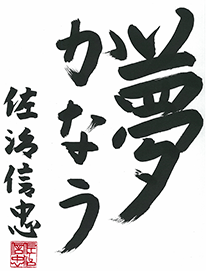
The first blue roses in the world were named "SUNTORY blue rose APPLAUSE," and marketed. The applause means cheers, and the blue roses signified "dreams come true" in the language of flowers. The flowers were given this name with the hope to send cheers to many people who have made efforts to make the dreams come true.
Blue roses were commercialized, but the Suntory's challenge to the impossible is not over yet. In the natural world, there are many flowers that are pure blue. These flowers are able to not only synthesize blue pigments but also produce pure blue by combining blue pigments with metal ions, such as aluminum, and various co-existing compounds with the blue pigments, including flavones. It is also known that the higher the pH in the cellular vacuoles in which blue pigments accumulated, the more pure blue the color is.
If such mechanisms to produce blue flowers are reproduced in roses, roses in more of a pure blue than the current APPLAUSE should be developed. Suntory's challenge to produce "pure blue roses" continues today.
The "challenge to the impossible" is not over yet −-Senior General Manager Yoshikazu Tanaka Ph.D.
![]()
Warm responses from consumers encourage me most −−Principal Researcher Yukihisa Katsumoto Ph.D.
![]()
Hope to sell APPLAUSE to overseas consumers --Researcher Noriko Nakamura Ph.D.
![]()
![]()
* The department name, title, and photo are as of the time of the production (interview).
* The department name, title, and photo are as of the time of the production (interview).
close
Next
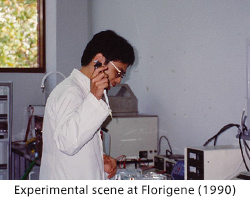
About 6 years after joining the company, I heard a rumor that Suntory would make a challenge to develop blue roses in collaboration with Florigene, a venture company in Australia. Because I was not especially interested in plants, I did not even know the fact that blue roses did not exist in the world. However, I felt I needed a change in my company carrier and wanted to work abroad, so I sort of volunteered.
At that time, I belonged to the laboratory of microorganisms, but was transferred to the plant research group with the initiation of the project, and immediately moved to Australia. At the beginning, I had difficulties because of the uniqueness of Australian English and I did not understand the context of daily research activities, but got used to the research life there quickly with the support of friendly colleagues.
- 01
- 02
- 03
close
Prev
Next
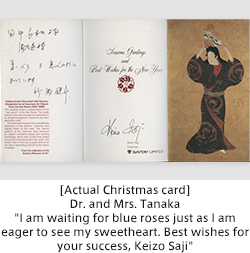
There were no big technical barriers for me to start working with plants because microorganisms and plants are much the same as far as molecular biology concerned. People often wonder how patient we had to be to look for two blue genes from 30,000 plant genes, but I knew research is such as I had dealt with fungi or mammalian genes. I did not find it really hard.
During the Christmas season, I received a Christmas card from the President at that time, Keizo Saji, with a handwritten message "I am waiting for blue roses just as I am eager to see my sweetheart." I was needless to say impressed with the witty message, but most of all, I was pleased that he remembered each of us employees dispatched abroad. I still treasure this card.
- 01
- 02
- 03
close
Prev
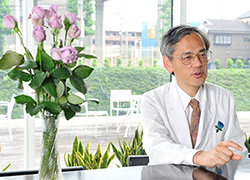
As we examined plant genes, I hypothesized that the ancestors of roses might have had blue genes and that blue roses might have bloomed tens of millions of years ago.
No current rose family has blue genes, which means that they were not necessary for the ancestors of roses to survive. They might have eliminated unnecessary blue genes at some point of time in the process of evolution.
All we can do is to imagine what kind of colors the ancient blue roses had, but if there were a time machine, I would love to see them. Perhaps, not only their colors but also their shapes were quite different from those of current roses.
- 01
- 02
- 03
close
Next
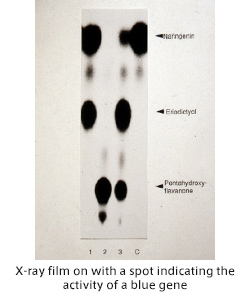
The work to isolate blue genes, which would be the key to producing blue roses, needed patience. We introduced isolated genes into yeast, grew them, and examined whether a precursor of blue pigments had been produced by exposing them to X-ray films---I patiently repeated this steady process.
On one day, a spot indicating the blue gene activities which I had not seen before appeared on an X-ray film. Finally we succeeded in isolating blue genes.
I cannot fully express the sensation that I felt at the time. Immediately, I sent a fax with a big circle mark to Japan. Although no word was written on it, colleagues in Japan knew what it meant, and shouted with pleasure, "They did it!"
When I said "I think I got one" to a colleague at Florigene, the news spread in an instant and they also got excited. A female director in charge was also pleased, with red eyes and tears. The president of Florigene bought us lunch on that day. We had a party celebrating the success at an Italian restaurant.
While everyone was pleased and excited, my colleagues from Japan and I were thinking about the possible difficulties in introducing the blue genes into roses and carnations. Even though we had isolated blue genes, all the efforts would be in vain without producing blue flowers.
- 01
- 02
close
Prev
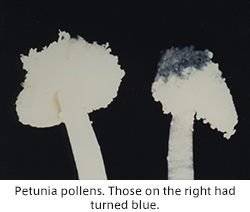
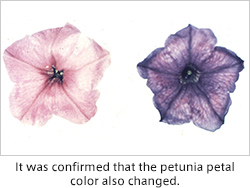
In July, we applied for the patent of blue genes. We found later that a competing research team also succeeded in isolating genes about the same time. Fortunately, however, we made the application earlier than them, and obtained patents without any trouble.
In the experiments to narrow down candidate genes, we used yeast to reduce the time to produce results, which was perhaps very fortunate for us. If we had used plants, not yeast, for the experiments, we might have made the application later and might have failed to obtain the patent right.
To express plant genes in yeast, we applied the yeast expression system that had been developed by medical research Suntory engaged at that time. As in this case, techniques that were developed in the past can sometimes be used for a totally different research later.
We introduced candidate genes into petunias, but the color of petals did not change, and we were disappointed for a moment. However, we took a closer look and found that the color of pollens only had turned blue. We screamed, "Thank God!" and laughed. It is such a nice memory. Subsequently, we confirmed that the color of petals could be turned blue, too. This was the moment when I was convinced that blue flowers of roses and carnations could be produced eventually.
- 01
- 02
close
Next

Around that time, I was busy helping raise funds at the Florigene in Australia. This was a 4-year project originally, but it took a much longer time to produce blue pigments in roses. There was financial support from Suntory during the first two years, but financial difficulties unique to venture companies continued subsequently, posing various barriers.
From the viewpoint of investors, it must have been hard to make an investment in the blue rose project which was taking several years, unlike software development that could be completed in half a year. Finally, we obtained funds, using a taxation system encouraging research and development in Australia.
Florogene could not make use of the system without the approval of Suntory, so I served as a negotiator between Suntory and Florigene.
- 01
- 02
- 03
close
Prev
Next
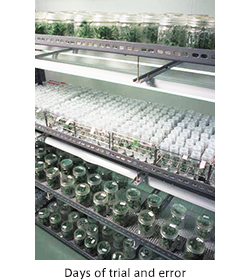
It took much trial and error to introduce the heterologous blue genes which had been once regarded as unnecessary by the ancestors of roses into rose cells and regenerate transgenic roses by tissue culture.
We had to use the power of a microorganism to introduce these genes into cells, and needed to conduct experiments to determine the strain of the microorganism to be chosen. At the same time, we also had to actually try to introduce the genes into a stalk and a leaf in order to determine which was better.
Introducing genes into plants and regenerating them required much more patience than isolating blue genes because steady efforts were necessary to test various factors repeatedly.
- 01
- 02
- 03
close
Prev
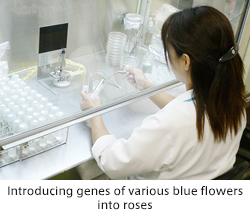
Roses did not turn blue even after blue genes were introduced--We repeated experiments, and at one point, I even suspected that roses might have mechanisms to decompose blue pigments. Because I would have been more stressed out by thinking about this matter too seriously, I kept telling myself that "research and development does not advance smoothly in most cases."
Under these circumstances, researchers engaged in tissue culture devoted themselves to the experiments of introducing blue genes of various blue flowers into rose cells. Only those with precise and patient personality could be engaged in this aspect of the research. The desks of those engaged in tissue culture were organized tidily, too. I, who left my desk messy, belonged to the molecular biology team to isolate blue genes (Smile).
- 01
- 02
- 03
close
Next
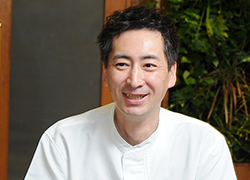
I engaged in plant science at university, and joined the company, longing to conduct research on blue roses in 1991. During the early days, partly as my training, I was given opportunities to conduct various studies including experiments on genes and enzymes. However, I had a strong desire to deal with living plants themselves. So I conducted tissue culture experiments after working hours, produced some results, and negotiated directly with my boss then. As I desired, I became a member of the blue rose project. My action was really in line with the spirit of "Yatte Minahare - Go for it!"
Introduction of blue genes into rose cells was a laborious and time-consuming series of steady work. However, I myself did not mind it at all because that was the work I wanted to do so much.
- 01
- 02
- 03
close
Prev
Next
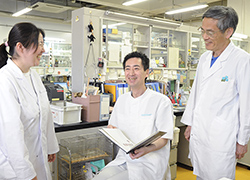
We had a series of failures in the development of blue roses, but each failure gave us a useful lesson for future research. Each time we examined flowers that had not turned blue, we found some hint that might be useful. It was enjoyable to find such hints and use them in the next stage. Because of this enjoyment, all the members, including myself, were able to continue daily research.
Each member of the team had his or her own specialty. Some were good at molecular biology, others at tissue culture, and others at chemical analysis. Nobody was able to conduct this research alone, so we depended on each other's specialties and cherished the sense of cooperation to make the dreams come true.
Regardless of our age and sex, the team members respected each other, recognizing the ability of the other members as professional researchers. Such mutual respect enabled all of us to continue to be positive.
- 01
- 02
- 03
close
Prev
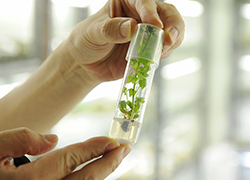
Even when no fruitful results were obtained, the team members did not give up and continued the research, believing the success. I again would like to express my appreciation to the company, which allowed us to continue this project for such a long time.
We knew that creation of something good would take time, as in the case of the aging of whisky. As signified by the term "Yatte Minahare - Go for it!" the challenging corporate spirit is unique to Suntory.
Without the spirit of "Yatte Minahare - Go for it!" the company would not have assigned me to the research team in my first year of employment or would not have allowed us to continue the blue rose project for 14 years in spite of the fact that the prospect for commercialization remained unclear for a long time. Perhaps the project would have been discontinued a long time ago at an ordinary company.
- 01
- 02
- 03
close
Next

Although targeted pigments could not be produced for a long time in roses into which genes of petunias had been introduced, blue pigments were expressed in carnations a little earlier. As this expression only was not enough to turn the flower color into blue, we had to use a little ingenuity and introduce a combination of the blue genes and another petunia gene into selected white carnations. With the accumulation of only blue pigments by this method, we succeeded in producing blue carnations. This method was applied in the subsequent development of blue roses, chrysanthemums, and lilies.
Because the color of carnations changed, there was no reason we wouldn't be able to change the color of roses. Because the blue genes had already been introduced, we were sure that we could produce blue roses eventually.
- 01
- 02
close
Prev
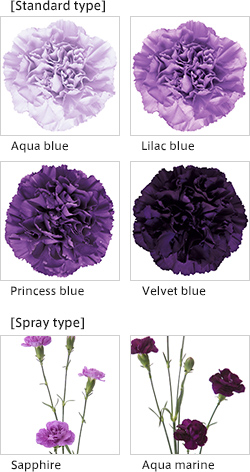
Since the first blue carnations in the world were released, they have been sold mostly for Mother's Day. It is very difficult to produce many flowers all at once for that day, and the farmers get extremely busy.
Moonseries carnations have a wide variety of colors. The difference in colors is due to the difference in the amount of pigments. Blue pigments accumulate in the vacuoles of petal cells, and the vacuolar environment of carnations is quite different from that of roses. Because the pH in the vacuoles of roses is low, an increase in the amount of pigments results in a reddish color. We can say that roses are not at all suitable for turning blue. It is strange that production of the same kind of blue pigments in chrysanthemums results in much more pure blue than in roses.
- 01
- 02
close
Next
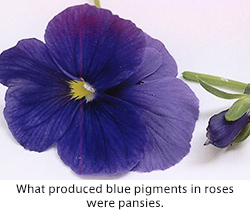
Genes of various plants, such as gentian and lavender were tried, but what produced blue pigments in roses were pansies. This was found with no necessity. We selected representative blue flower species from each category of plant classification named "family," and tried various flowers, and succeeded in the experiments of pansies quite by chance. There was no presumption that pansies would work.
Experiments were conducted jointly in Japan and Australia, and blue pigments were first produced in Australia, so I felt a little disappointed. Since the time when I returned to Japan in 1994, experimental systems in Japan improved, and experiments were conducted in parallel with experiments in Australia. Subsequently, experiments introducing genes of pansies were also conducted in Japan.
- 01
- 02
close
Prev
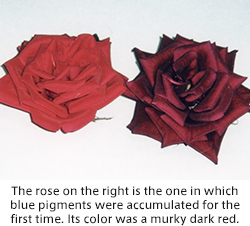
When blue pigments were expressed in roses for the first time, their content was about 50% of total pigments. Still, we were all excited to receive the news. The change from zero to one (from absence to presence) was a big breakthrough.
The color of the roses was not blue but murky dark red at best. But we had a bright prospect because we believed that the color would turn blue someday with continuous efforts to improve it.
Even if the amount is small, there is a big difference between zero and one when we think about future possibilities. We were convinced that "this was a good result, indicating that our research was advancing in the right direction." This was a big turning point in the blue rose project.
- 01
- 02
close
Next
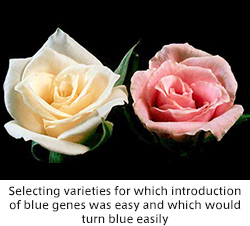
Introduction of blue genes is relatively easy for some rose varieties whereas it is not for the other varieties. First, we introduced the genes to red roses. It was difficult to turn them blue, so we started to choose varieties for which introduction of the genes was relatively easy and which would easily turn blue.
It has been often pointed out that white roses may easily turn blue, but many white roses do not have the ability to produce pigments, and they do not necessarily turn blue even if blue genes are introduced.
We do not know yet why it was more difficult to produce blue pigments in roses than in carnations. As plants have mechanisms to degrade unnecessary nucleotide sequences, for example, the petunia blue gene might have happened to be the sequences that the roses wanted to degrade. However, this is only my imagination. There is no big difference between roses and carnations as to how easy it is to introduce genes.
- 01
- 02
close
Prev
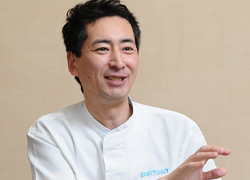
Some people have said to me, "You must have been patient not to give up the project when no fruitful result was obtained." If the members who are directly involved in this kind of project do not believe in the success, it will never be successful.
To think positively and consider that "there is no reason not to be successful" is just about the right attitude. If there had been even one team member who had given up, APPLAUSE would not have been born.
I felt pressure due to the expectations and dreams that many people had, but I even enjoyed the sense of pressure. If nobody had cared, there would have been no pressure, but the work itself would not have been worthwhile. I have worked, considering that I have been expected to do so.
- 01
- 02
close
Next

We were advancing research to develop roses that really would look blue in 1999. It was decided that the progress of the selected research projects should be reported directly to top management twice a year, and the blue rose project was chosen as the subject of the reporting.
I was first told to make a report once in three months, but I told them that I wanted to do so only twice a year, saying "Roses don't grow in three months" (Smile). It was hard for me to give easy-to-understand explanations to the executives, who were not specialized in this area.
Once I was very careful to make my presentation easy to understand, and one executive said, "Good! Now I know that you will create roses soon." I still remember the difficulty of preparing presentation.
- 01
- 02
- 03
close
Prev
Next
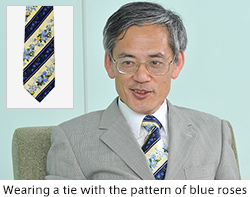
There was one impressive incident in a report meeting. On that day, I wore a tie with the pattern of blue roses as it was the least I could do then. My senior director happened to wear a tie with blue roses, too, so we said to the vice-president then, "Today we are both wearing ties with blue roses." Then he said, "You were saying that you were creating blue roses, but you meant you were creating ties with blue roses." When I heard that, I was already nervous before the presentation, and I could not say even a word in response (Smile).
At this report meeting, in front of the president and the executive vice president, I promised to produce blue roses by September 2002. Because of the pressure, the president asked me, "Haven't you created blue roses yet?" in my first dream of the new year.
- 01
- 02
- 03
close
Prev
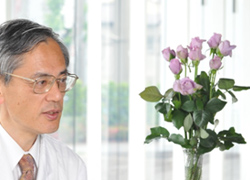
We produced roses with the content of blue pigments close to 100%, but whether they really looked blue depended on subjective view. Therefore, we decided to ask for the judgment of the president, and I took the blue roses with me to the president's office in September, 2002. I had to prepare myself for the worst. In case of being told that the roses were not blue, I prepared presentation materials to be used to make an excuse.
Therefore, I was so relieved when the president said, "They are blue! Good job. Promises are seldom fulfilled." Later, another researcher talked about that conversation to the president on the occasion of his training, he said, "I said that, partly to flatter him" (Smile). His thoughtful statement to thank me for my efforts encouraged me to produce roses of pure blue.
- 01
- 02
- 03
close
Next
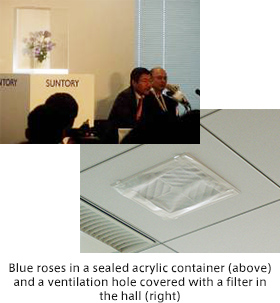
It was decided to hold a press conference on the success of the development of the blue roses in Roppongi Hills with the presence of the president, and with real blue roses exhibited. At that point of time, it was difficult to exhibit them because no permit for the genetically modified blue roses had been obtained and they could not be carried out of the specified laboratory as they were.
In consultation with officials of the Ministry of Education, Culture, Sports, Science and Technology, therefore, we put the flowers in a sealed container and temporarily converted the press conference hall to a laboratory compatible to genetically modified DNA experiments by installing filters in the ventilation holes. However, on the day of the conference, bullet trains were stopped due to heavy rain in Shizuoka, and the roses were not delivered by the trains.
We almost cancelled the conference, but the roses were carried by an airplane and arrived at the hall just before the conference. It was the first press conference for me, so I myself thought such a situation could occur occasionally. However, I later heard that the staff members of the Public Relation Department felt that the conference, which was full of unexpected incidents, would take several years off their life.
- 01
- 02
close
Prev
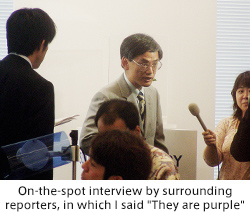
Usually people engaged in research and development don't appear in a press conference. I had never thought that I would attract attention from media. As I was not used to that kind of occasion, I made some mistakes.
A reporter said to me, "They are purple, not blue, aren't they?" and I should have said, "This is the blue color in the world of roses," but I inadvertently said, "They are purple." Because of my comment, a caption, emphasizing the word "Purple" in bold letters, was shown in a news program. I memorized Q & A that had been anticipated, but did not remember correctly how I should have answered other questions.
Still, we received excellent responses to the press conference. Our announcement was publicized extensively, and was even covered by the foreign mass media. From the next day, I was extremely busy dealing with a tremendous number of reporters.
- 01
- 02
close
Next
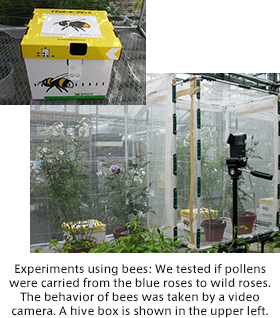
To produce and sell the genetically modified blue roses, we had to prove, as much as possible, the absence of effect on the ecological system in order to obtain the permits of the Ministry of Agriculture, Forestry and Fisheries and the Ministry of Environment. Unlike carnations, which rarely produce viable pollens if any, the roses produce many fertile pollens (pollens that have the ability to produce progeny by hybridization), and many wild rose species grow naturally in Japan. Therefore, the Ministry of Agriculture, Forestry and Fisheries wanted us to show that there was absolutely no effect, and conducted extremely strict examinations.
In experiments in a greenhouse, we actually released bees and studied if pollens were carried from the blue roses to wild roses. We also examined the distribution of wild roses around the experimental field, actually collected fruits within 500 m, and tested whether each one of the thousands of small seeds had been produced as a result of cross hybridization. This work was extremely laborious. For outdoor experiments, cooperation of residents in the surrounding areas was essential, and everybody supported us amiably.
- 01
- 02
- 03
close
Prev
Next

The hardest experiments were "hybridization experiments" to examine the dispersal of the introduced genes by possible pollinating wild roses with the blue rose pollens. First we examined three representative kinds of wild roses. Considering the possibility that hybridization might be easier between plants with similar genome structures, it was decided to perform additional validation at places in which they grew naturally.
The species we selected was a rare one (Rosa acicularis), which grows naturally only in Tohoku District and in areas further north, and it was difficult to locate roses of this species. A rose lover told us about one farming field in Hokkaido, but it was in the wilderness in which there was a signboard, saying "Watch Out for Bears." With many bees flying around the flowers, I, who disliked insects, patiently put pollen from blue roses (host) on the pistil of wild roses almost crying.
Perhaps because this sight was really rare, a fox (Vulpes vulpes schrencki) was watching us (Smile).
- 01
- 02
- 03
close
Prev
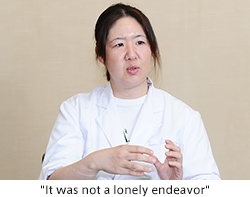
While I was conducting various experiments to obtain the permits necessary for marketing, I truly felt how much I was supported by many people, including those living around the experimental field. The network of rose lovers also helped me a lot. They not only taught me about the farming field in Hokkaido but also kindly surveyed and gave me copies of pages of a picture book with the shapes of rare rose fruits.
Although officials of the Ministry of Agriculture, Forestry and Fisheries told us that they would make a judgment carefully because there was no precedent, a public relations advertisement mentioned Suntory would release the roses as early as in 2007. Therefore, I had tremendous pressure, and the investigation on the distribution of wild roses in mountain areas was hard, but it was not a lonely endeavor. I knew that people outside of Suntory also supported the blue rose project, which was really reassuring.
- 01
- 02
- 03
close
Next
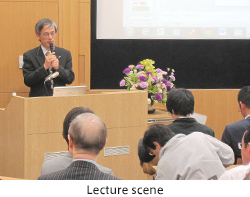
After the public announcement of our success, we obtained the permit from the government and established a production system. Finally, after five years, we put roses on sale. Even now, several years after their release, I still receive requests for interviews and lectures. I have been pleased with these requests, but I have been thinking, "Rather than dwelling on the past. I should think about the future direction."
Since the release, I have received many responses from consumers. Some say that "the color is unprecedented blue," but others say that "it is not blue but purple." Some asked us to "create roses of pure blue."
Sometimes I receive compliments about fragrance of the blue rose, but the pathway to produce colors is quite different from the pathway of biosynthesis of fragrant compounds. Because the genetic modification only changed colors, and fragrance and shapes are the same as those of original roses, I have slightly mixed feelings when I receive compliments about fragrance.
- 01
- 02
close
Prev
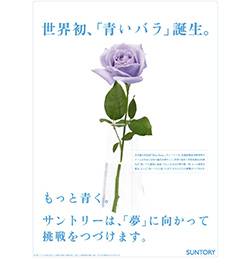
Elementary and junior high school students wrote me letters. It is a pleasure for me as a researcher if blue roses make them interested in science. From the days when I was an elementary school student, I myself liked not only plants but also living creatures in general, and often looked at animal encyclopedia. I was moved when I noticed that bacteriophage and a lunar lander looked similar.
People often say to me, "It must be hard to conduct research that nobody else has ever done, groping your way forward," but in principal, research is to do something that no one has done.
We can open up a new way if I try to apply new ideas and knowledge we learned from other studies and do whatever possible, believing that there is "no reason not to be able to succeed."
- 01
- 02
close
Next
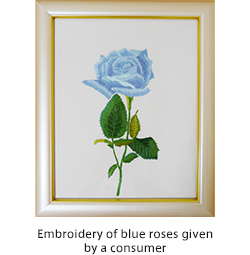
The moments when I was most pleased to engage in this project were not when we obtained good experimental results but when we received warm encouraging responses from general consumers after the announcement of the success in the development of blue roses.
A woman in her 80s sent us a handmade embroidery with a motif of blue roses, along with a letter, saying, "I am glad to have lived long to see the roses." I am moved to tears to think of her, putting in one stitch after another for someone that she didn't know.
People who are not interested in flowers may not care whether roses are blue or red. Nevertheless, there were a tremendous number of people who called the birth of blue roses "realization of hope" and "dreams come true." I was glad to have continued this work from the bottom of my heart.
- 01
- 02
- 03
close
Prev
Next
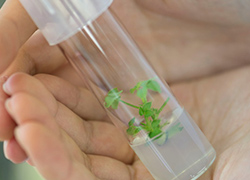
The members of the laboratory always ask themselves how the products they are creating will be received by consumers and how much value they have. In daily life, researchers do not interact with consumers. We work in the farthest place from consumers. Nevertheless, many consumers send us responses, which give the ultimate pleasure for us who make a living as researchers.
One of the reasons why we received so many responses is perhaps the fact that it took a long time to succeed. APPLAUSE was created after many struggles, and each consumer was waiting for it. Thus, many consumers shared our feeling that blue roses were special. I would like to do my best to brighten up the blue color in order to meet their expectation.
- 01
- 02
- 03
close
Prev
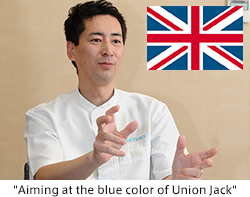
The best way to brighten up the blue color is to learn from the nature. We should not only change rose varieties but also examine what mechanisms of other blue flowers make them really blue, and imitate them with roses. For this purpose, procedures more complicated than the procedures of creating APPLAUSE will be necessary.
I have heard about a story about the initiation of the blue rose project; one of the reasons for its initiation was that then-President Keizo Saji wanted to return a favor to the people in Scotland who helped whisky production. Creation of the blue color of Union Jack would be a true repayment of the favor. Thus, my ultimate goal is that dark blue color.
- 01
- 02
- 03
close
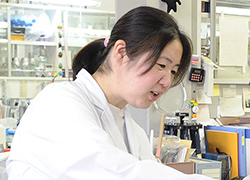
Currently, APPLAUSE is put on sale only in Japan in the world.
However, because the news on the success in the development of the first blue roses in the world were reported widely in foreign countries, many people wish to have a look at APPLAUSE. For those people, I hope that APPLAUSE will be released overseas as soon as possible.
As in Japan, we have to overcome many hurdles to release it overseas. Someday, to fulfill Suntory's dream to return a favor to Scotland, blue roses will hopefully be delivered to that land across the ocean.
Source: https://www.suntory.com/sic/research/s_bluerose/story/
0 Response to "Blue Rose Turn Black Ministy Video Blue Rose Boat Video Aids Spanish"
Postar um comentário